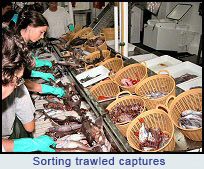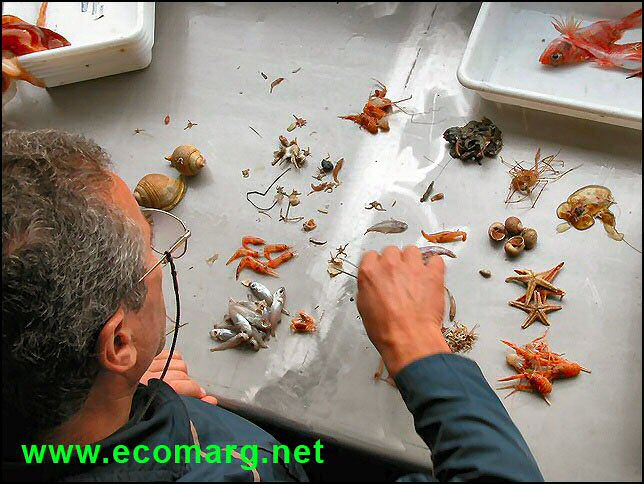
| Welcome to ECOMARG PROJECT website |

|
 |

|
1. Sampling
 The great variability of habitats in the study area causes a wide variety of morphologies and behaviours of the species inhabiting them. Therefore, it is essential that different sampling systems are used so that all the information needed to understand the functioning of the ecosystem can be accessed. The methodology used by ECOMARG contemplates sampling the different compartments of the benthic domain. Epibenthos and demersal fauna are sampled using three different trawling gears: the Porcupine Baca trawl, the rockhopper and the beam trawl. The former two are characterized by a high efficiency in capturing large-sized demersal swimming species, and a lower one for epibenthic species. The Porcupine Baca trawl is used in soft bottoms, while the rockhopper is used in rocky ones. The beam trawler is more efficient for epibenthic fauna: flat fish and occasional swimmers, sessile species and small invertebrates. In rocky ledge areas qualitative sampling is conducted using a rock dredge. Endobenthos is sampled using a megabox-corer, while suprabenthos is sampled using an Arcachon type sledge. The benthopelagic plankton is captured with a WP2 type net. Sampling by trawling and dredges is complemented with visual techniques: photogrammetry sledges (TFS-1 and TFS-2) and remotely operated vehicles (ROV). Once on board samples are classified at the lowest taxonomical level possible, size distributions are obtained and the stomach contents analysed.
The great variability of habitats in the study area causes a wide variety of morphologies and behaviours of the species inhabiting them. Therefore, it is essential that different sampling systems are used so that all the information needed to understand the functioning of the ecosystem can be accessed. The methodology used by ECOMARG contemplates sampling the different compartments of the benthic domain. Epibenthos and demersal fauna are sampled using three different trawling gears: the Porcupine Baca trawl, the rockhopper and the beam trawl. The former two are characterized by a high efficiency in capturing large-sized demersal swimming species, and a lower one for epibenthic species. The Porcupine Baca trawl is used in soft bottoms, while the rockhopper is used in rocky ones. The beam trawler is more efficient for epibenthic fauna: flat fish and occasional swimmers, sessile species and small invertebrates. In rocky ledge areas qualitative sampling is conducted using a rock dredge. Endobenthos is sampled using a megabox-corer, while suprabenthos is sampled using an Arcachon type sledge. The benthopelagic plankton is captured with a WP2 type net. Sampling by trawling and dredges is complemented with visual techniques: photogrammetry sledges (TFS-1 and TFS-2) and remotely operated vehicles (ROV). Once on board samples are classified at the lowest taxonomical level possible, size distributions are obtained and the stomach contents analysed.

Sorting captures obtained with the beam trawl
2. Information analysis
The inventories from the biological treatment of the samples are stored in a database from which precise matrices will be extracted for each statistical analysis. The importance of species is expressed as a function of their frequency and relative abundance in number or biomass (number of individuals or biomass per surface unit for the epibenthos and demersal fauna, and per volume unit for the endobenthos, suprabenthos and benthopelagic plankton). The different ecological indices are obtained from the ecological matrices per haul. The ECOMARG philosophy consists of integrated analysis of the biological and physical elements of the ecosystem. Thus, statistical analyses are aimed at interpreting the faunistic variability in relation to environmental data. Community structure is investigated using hierarchical ordination techniques and its relation to environmental data using canonical analysis. The spatial distribution of the communities and its relation to environmental variables will also be analysed using geostatistical techniques. The final aim of the project is integration of all this information into a trophodynamic model.
 Up
Up |

|
 |

|
















